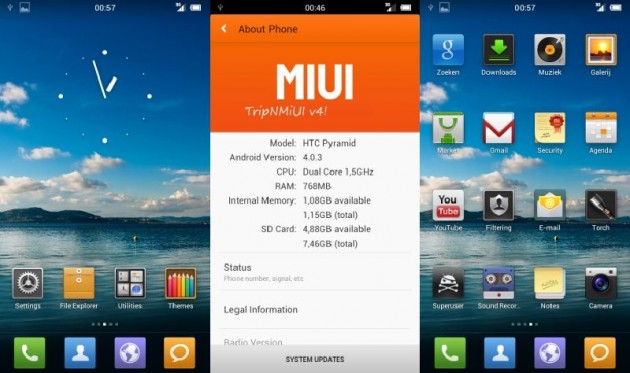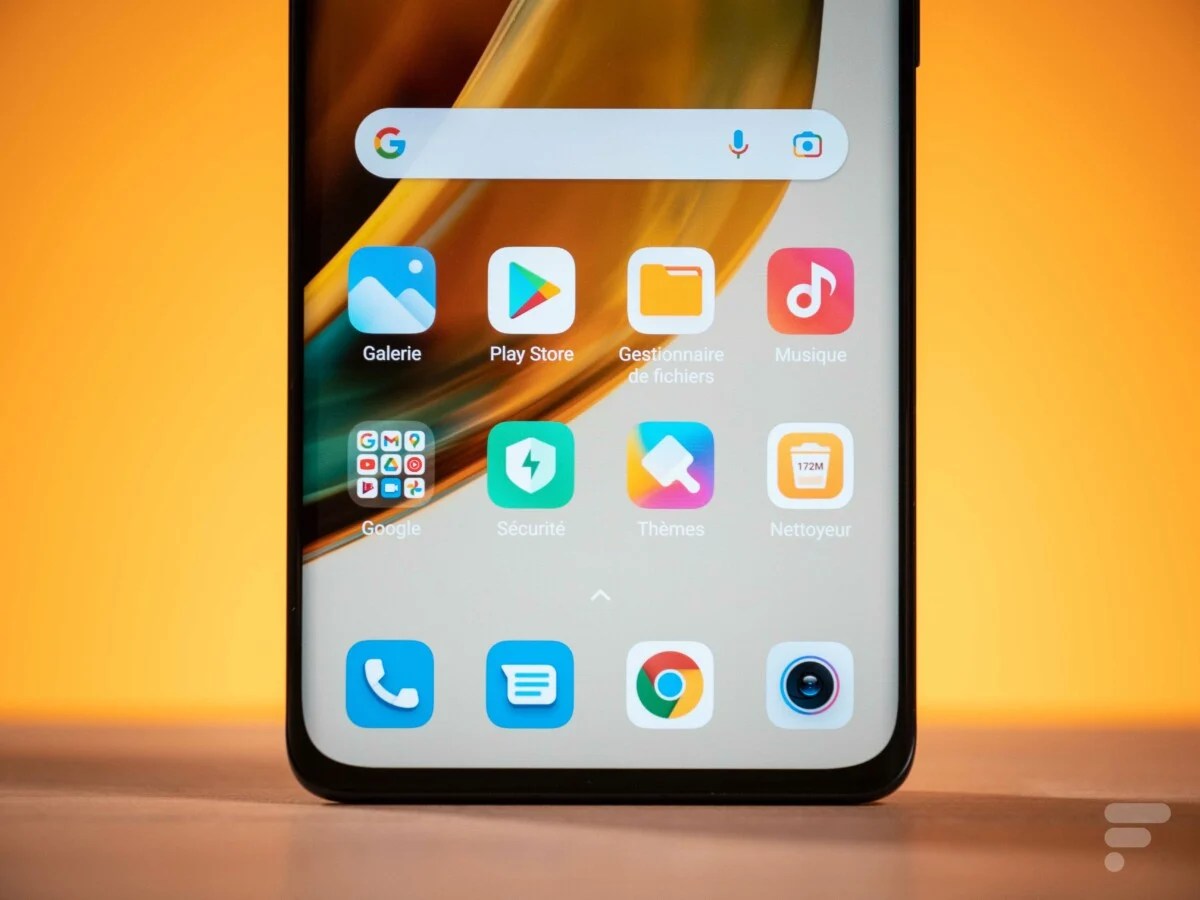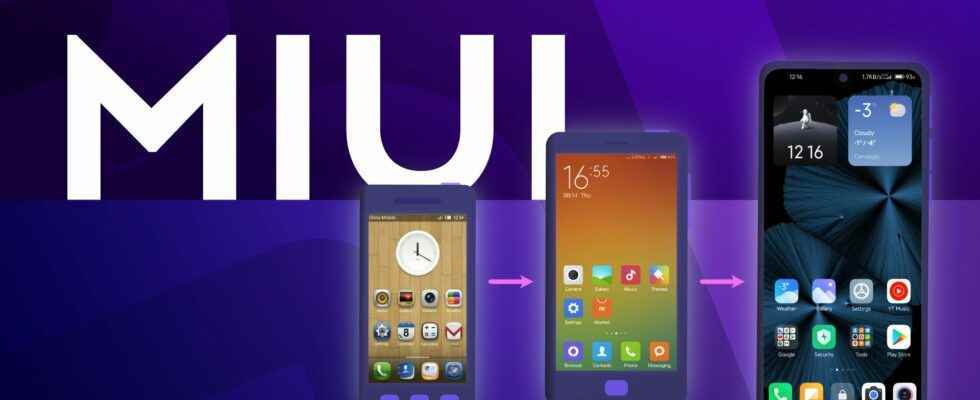With 12 years of experience on the clock, Xiaomi is an essential brand when it comes to smartphone interfaces. MIUI, which can be found on all its current terminals, was indeed launched in August 2010. The opportunity to do a retrospective… and to note that the brand has often been a forerunner in this field.
Light the candles, next August 16 MIUI will celebrate its 12th anniversary. It was indeed in 2010 that Xiaomi, then a young start-up launched a few months earlier, released the very first version of its interface. Since then, MIUI has come a long way. And if we stopped on the main stages and progress of his career?
From MIUI 1 to MIUI 4: the first steps… and the great discoveries
Do you remember the interfaces from the early 2010s? If you have mixed memories of it, that’s completely normal. Between the limited power of smartphones, their very small screens and a fledgling mobile internet, interfaces were above all asked to simplify access to telephone functions (calls, SMS, contact)… and possibly to add a few options to make life easier here and there.
At the beginning of the 2010s, Xiaomi was well aware that the interfaces of the first Android smartphones still had a lot of progress to make. The very recent start-up then embarked on the development of its own ROM: MIUI. A simple and mischievous name at the same time. It is pronounced as in English “Me You I” (pronounced “Mi, you, aï) and refers in parallel to the UI, for User Interfacethe user interface.

The very first version of MIUI was therefore released in August 2010. This fork of Android was already very noticed during its deployment. Contrary to what the competition of the time offers, the icons are pleasant and colorful, far from the austerity of the first versions of Android offered by Google.
This very first version of MIUI is also not backed by any official phone of the brand. It is possible to install it on a Google Nexus (the ancestor of the Google Pixel) or on an HTC Desire, but its implementation is difficult: you have to root the phone – and therefore erase all its data – to take advantage of it.
MIUI v1, like the four iterations that will follow until 2013, is already full of good ideas to make life easier for the user: possibility of installing applications on the SD card, more intuitive SMS application, application uninstallation one-click, lock screen shortcuts, moving app icons between launcher screens, etc. So many possibilities that seem obvious today, but which had to be thought out and invented in the early 2010s.
YouTube linkSubscribe to Frandroid
An enthusiastic advertisement detailing the main features of MIUI V4. English subtitles are present at the bottom of the video.
However, there were dozens of interfaces, forks or ROMs for Android in the early 2010s. Xiaomi’s stroke of genius was then to have this interface translated very quickly into around twenty languages to unite an international community of fans. In France, dedicated forums are appearing. They promote MIUI, teach newcomers how to install it, and escalate issues to Chinese developers. Slick interface and community on the lookout: the foundations for future success are laid.
MIUI 5 and MIUI 6: Xiaomi’s head start
If the first versions of MIUI are promising, it is especially from the fifth, released in March 2013, that the interface of Xiaomi begins to become a reference of its kind. The period is auspicious for Xiaomi. Its first smartphones, the Xiaomi Mi 3, Mi 4 and Mi5, are huge successes in China. At the same time, Google is rolling out the Jelly Bean and KitKat versions of Android, major releases of the OS that incorporate important new features.
YouTube linkSubscribe to Frandroid
In terms of design, MIUI 5, released in 2013, still shares a lot of visual codes with our current interfaces.
In 2014, the editorial staff of Frandroid took stock of the main new features of MIUI 5. 11 new features had caught the attention of the journalist at the time, and more particularly the launcher (or office). This had been worked on to make the organization as practical as possible with the presence of a search engine and the possibility of moving or deleting applications in batches.
But the most impressive was undoubtedly the security aspect of this interface. Several years ahead of the competition, Xiaomi had implemented a cutting-edge application permission management system: “When launching certain applications such as Twitter or Angry Birds, MIUI will ask the user to approve certain permissions requested by the application. So, MIUI asked me if I wanted to allow Twitter to access my contact book.” Android will integrate this permission management natively only two years later, with Android Marshmallow.

If MIUI 5 adds a lot of new features to the interface, MIUI 6 focuses on aesthetics and design. With brio. Just look at the screenshots taken by the editorial staff in 2014 to realize how pioneering Xiaomi was in terms of design. Admittedly, the brand is in tune with the times with icons and an interface entirely in flat design. But the sobriety of the icons and the very clear layout of the menus is still very close to what we find on our current smartphones.
YouTube linkSubscribe to Frandroid
With MIUI 6, released in 2014, Xiaomi laid the design foundations for current MIUI versions.
MIUI 10 and MIUI 11: adapting to large screens
In 2018, Xiaomi announces the arrival of MIUI 10 and a significant amount of new features. Smartphones then experienced a considerable technological change with the democratization of very large screens “borderless”. Now in 18:9 or 19:9 ratio, the screens are spread over the entire front of the device. This poses new constraints for the interfaces: on the one hand, they must better take into account this new space and above all ensure that the top of the screen, which is now more difficult to access for users’ thumbs, can display the notifications correctly.
YouTube linkSubscribe to Frandroid
At the end of 2018, MIUI 10 is therefore deployed on Xiaomi’s main smartphones, including some devices released 3 or 4 years ago. With this new version, Xiaomi integrates gesture navigation for the first time, which is much more practical on large screens. The design, shimmering, is then very far from what we find in other brands of Android smartphones. However, it is widely acclaimed by the Xiaomi fan community.
MIUI 10 is just Xiaomi’s first step in bringing the best possible interface to large screens. In 2019, MIUI 11 goes even further by offering a redesign of the interface: the menus are more airy, the design of the icons has been revised and above all, to adapt to the Western public, the application drawer on the launcher signs his big comeback.
YouTube linkSubscribe to Frandroid
MIUI 11 also adapts to the move upmarket of Xiaomi smartphones, which are now almost all equipped with an Oled or Amoled screen. MIUI 11 therefore offers a dark theme by default and extensive customization of the screen saver mode. always on. It is undoubtedly one of the best interfaces developed by Xiaomi to date.
MIUI 13: focus on fluidity and practicality
The latest version of MIUI is MIUI 13, released at the beginning of 2022. This new interface is available today on the majority of Xiaomi smartphones. MIUI 13 is the culmination of 12 years of thought, research and development.
Xiaomi didn’t just adapt the basic Android interface. With MIUI 13, gestures are at the center of the user experience. In swiping on certain parts of the screen, it is thus possible to display specific menus more easily. Customization of icons, themes or screen Always On is particularly advanced. The data cleaning and security tool preinstalled on Xiaomi phones is among the most practical on the market.

Above all, MIUI 13 is an example of fluidity compared to the interfaces of competing manufacturers. The Chinese brand has particularly worked on the animations of its menus, the interactions with the notification tiles, the haptic feedback and even the sounds so that its interface is always a pleasure to use. Xiaomi has also worked a lot on the multitasking mode, which is displayed vertically and not horizontally like on other smartphones. A much more ergonomic way to manage open or closed applications than the competition.
As usual, MIUI 13 is and will be available on all outgoing Xiaomi smartphones in 2022. It is also deployed on a good part of Xiaomi’s catalog of smartphones released since 2020.
